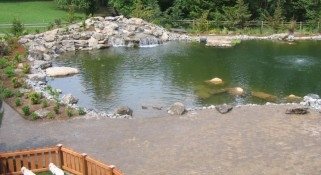A Landscape for Nature Lovers
A man-made lake and stream create the ideal environment for native flora and faunaWouldn't it be great go swimming and fishing in your own private lake, without ever leaving your backyard? The owners of this home, located in the Pacific Northwest along the Washougal River, have that luxury. Avid about the outdoors, they wanted their landscape to be a recreational retreat, while offering a hospitable environment for local wildlife. They also loved to fish and wanted to turn a natural depression in their backyard into a small lake that they could populate with native species of game fish. This man-made lake environment is a haven for many land animals as well. Local black-tailed deer, squirrels, and rabbits are frequent visitors, with wood ducks stopping by during their migration.
Key Design Features
The lake is approximately 50 feet by 90 feet, and ranges in depth from 3 feet in an area intended for swimming to 12 feet. On one side of the lake, is a large patio with stone slabs steps that lead down to the swimming area. On the opposite shore is a suspended stone dock for fishing and a waterfall that flows over large natural-stone boulders. A small grotto was created so swimmers can sit beneath the cascading water.
Off to the side of the main waterfall runs a stream planted with Black-Eyed Susans, Echinacea, Shasta Daisies, vine maple trees, and Miscanthus. "This area will become a mass of color as the year progresses," says Jason Sarvela of Woody's Custom Landscaping, which excavated the lake and installed all the stonework and landscape plantings. "To add to the natural feel, the water in the stream runs over windswept moss boulders found at a nearby rock pit."
Project Highlights:
-
Location: Washougal, Wash.
-
Intended use: Recreational fishing and swimming, raised-bed gardening
-
Budget: $300,000
-
Project size: 1.5 acres
-
Landscape design: Christine Ellis, Gregg and Ellis Landscape Designs, Portland, Ore.
-
Landscape installation: Woody's Custom Landscaping, Battle Ground, Wash.
-
Awards: Washington Association of Landscape Professionals (WALP) Distinction Award for Landscape Construction
At the front entry of the home is another fish-friendly water feature, a small pond inhabited by Japanese Koi fish. The entryway is paved with mortar-set Iron Mountain flagstone, a predominantly blue-black stone with rust-toned highlights. It extends over the Koi pond, forming a footbridge under which the fish can swim freely back and forth.
Another landscaping highlight in the front of the home is a serpentine retaining wall faced with cultured stone, which was used to frame the home's terraced front lawn. Precast stone was also used to create raised garden beds that the homeowners use to grow herbs and vegetables. Paver walkways were installed around the raised beds to provide easy access.
"The landscape trend in our area has been going more and more towards incorporation of hardscaping into outdoor living spaces," says Sarvela. Homeowner preferences were the main factors considered when deciding on the selection of hardscaping materials and plantings on this project. But in many cases, local materials were used, such as stone boulders from area quarries.
Project Challenges
This project was installed in the late fall, winter, and early spring, during the coldest, wettest time of the year in the Pacific Northwest. "The schedule of events became a critical factor, depending on whether it was going to rain, freeze, or snow," says Sarvela. Fortunately, excavation of the lake went fairly quickly, with the weather holding off during process, says Sarvella, who estimates that about 600 cubic yards of soil was removed using a combination of excavation equipment including track hoes, a front-end loader and a Ditch Witch multipurpose track machine. Track hoes were also used to place the large boulders that line the lake and form the water features.
After the project began, the homeowners decided to increase the size of the lake size by 20 feet so they could cast their fishing lines across the water. "This made for a significantly larger volume of water than originally planned," says Sarvela. More than 300,000 gallons of water, to be exact, which came from a well on the site. Over 33,000 gallons per hour of water flows over the falls. "This required three separate pumps and vaults to pump all the water to a filter behind the main waterfall," says Sarvela.
Multiple skimmers are located around the lake with intakes from the bottom. An aeration device along with the addition of an environmentally friendly microbial bacteria also aid in keeping the water healthy and clean, for both the fish and the daring skinny dipper. "At the deepest end of the lake, algae is a factor," says Sarvela. "The addition of the microbial product encourages the growth of normal beneficial bacteria that feeds on the algae."
Submit your project to LandscapingNetwork.com

 Backyards
Backyards
 Front Yards
Front Yards










